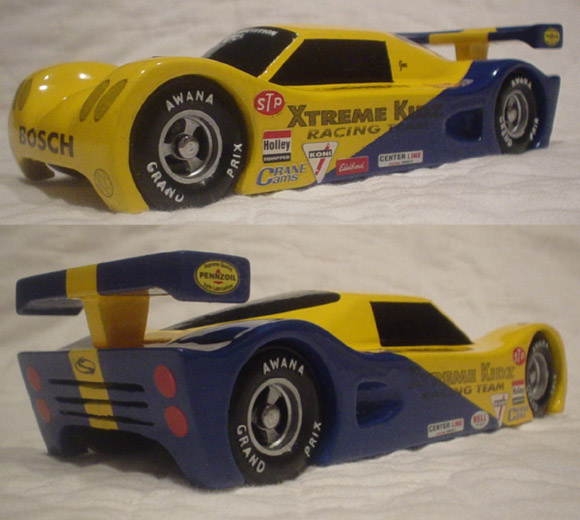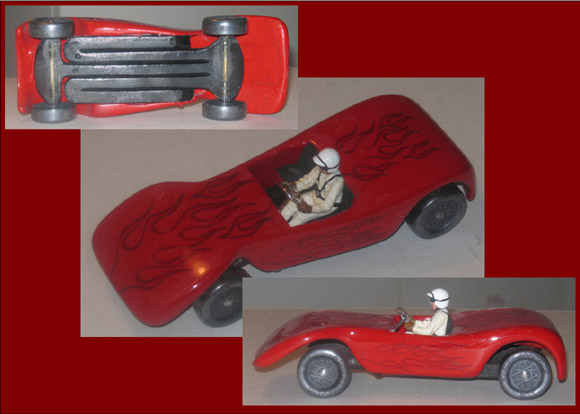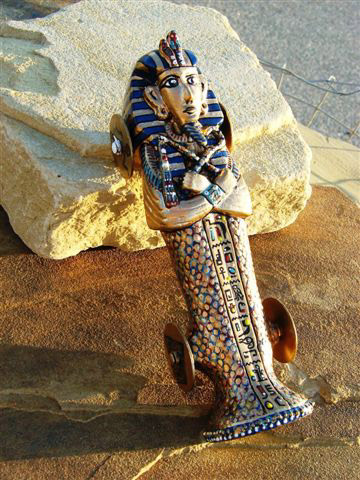– Feature Article – Weight Distribution: Concentrated or Distributed?
– Pinewood Derby Car Showcase
– Memory – Last to First
– Q&A
Weight Distribution: Concentrated or Distributed?
Weighting a pinewood derby car seems to be such a simple issue; just get it to five ounces and keep it towards the rear of the car (on most tracks). While this is true, to thoroughly cover the topic, the following must be considered:
- Weight Amount; see Volume 3, Issue 14 – “Weight Experiments: Effect of Weight Amount and Location”
- Weight Placement; see Volume 5, Issue 10 – “Weight: Place It Carefully”
- Weight Distribution; this article
As indicated above, the amount of weight and the placement of the weight have been previously discussed. But until now we have not covered the question of weight distribution.
What is Weight Distribution?
As you probably know the placement of weight on the car, along with the car body, wheels, and axles, will result in a center of gravity (COG) for the car. However, a given COG can be achieved via an infinite number of weight distribution schemes. For example, in Figure 1, both Cars A and B have the same COG, however, the weight distribution is quite different on the two cars.
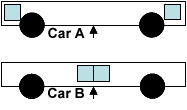
Different Weight Distribution, Same COG
Does Weight Distribution Matter?
The distribution should affect the performance for at least two reasons: rotational inertia, and vibration dampening.
Rotational Inertia
On standard tracks, the car starts on a slope, transitions a curve, and then finishes on a long flat section. In general, the weight distribution has no effect on the car as it travels the slope and the flat section. However, from a physics viewpoint, the weight distribution should affect the behavior of the car while it negotiates the curve.
The physics principle that is involved is ‘moment of inertia’, also referred to as ‘rotational inertia’. To cause a non-moving object to rotate, a force must be applied to the object. The moment of inertia is basically the resistance of the object to being accelerated around its COG.
When a pinewood derby car travels through the curve, it must rotate from the starting angle to a horizontal position (see Figure 2). Energy (force) is required to make this rotation occur, and this energy can only come from potential energy of the car. Thus, the moment of inertia will rob some energy from the speed of the car. Minimizing this force by minimizing the moment of inertia should improve the speed of the car.
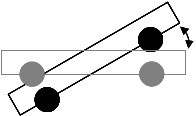
Rotation During Curve Transition
Let me give you an example of rotational inertia from golfing. When a golfer swings a putter, the goal is to keep the head of the putter perpendicular to the direction of the stroke. However, there is a tendency to twist your hands causing the head of the putter to rotate, resulting in the ball going the wrong direction.
Putter manufacturers understood this problem, so they introduced putters with a larger moment of inertia. These putters require more force to rotate the head, so the putters tend to produce better results. How did they increase the moment of inertia? They did this by the distribution of weight within the head of the putter (see Figure 3). Instead of using a solid head putter (with the weight evenly distributed), the head was redesign to have most of the weight at the toe and the heel of the putter head (some manufacturers place tungsten weights at these locations). This weight distribution has a greater moment of inertia, and thus produces more stable putts.
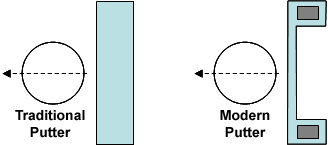
Moment of Inertia in Putters
Vibration Dampening
While the car is moving down the track, it will encounter obstacles that will cause the car to shake or vibrate. These obstacles include track debris (dust, hair, graphite, etc.), track surface flaws, and rough joints. The resulting vibrations will tend to slow down the car. If the weight is distributed over the wheels of the car, the vibrations will tend to be dampened or suppressed more than if the weight is concentrated in one location.
Catch 22
So, on the one hand the weight should be concentrated to minimize rotational inertia, but on the other hand, the weight should be distributed to minimize vibration. Which is more important? It is time for some experiments.
Experiment 1 – Rotational Inertia
First, a rotational inertia experiment was run using our Pinewood Wizard car. Heats were run with the weight concentrated in the center of the car, and then with the weight placed at opposite ends of the car. The track surface was very clean and smooth, with smooth joints. If rotational inertia is important, then the configuration with the concentrated weight should produce faster runs.
However, this was not the case. Per Figure 4, the distributed configuration outperformed the concentrated configuration (albeit by a very small amount). Although the difference in times was less, the same outcome occurred with both BSA and Outlaw style wheels.
| Outlaw |
BSA |
|||
|---|---|---|---|---|
| Trial | Conc | Dist | Conc | Dist |
| 1 | 2.610 | 2.607 | 2.638 | 2.625 |
| 2 | 2.613 | 2.601 | 2.637 | 2.627 |
| 3 | 2.603 | 2.601 | 2.650 | 2.629 |
| 4 | 2.604 | 2.599 | 2.642 | 2.627 |
| 5 | 2.608 | 2.601 | 2.638 | 2.627 |
| Ave | 2.608 | 2.602 | 2.641 | 2.627 |
| Delta | -0.006 | -0.014 | ||
Figure 4
Concentrated vs. Distributed Weight Distribution – Smooth Track
Experiment 2 – Vibration Dampening
The previous results indicate that vibration damping is more important than rotational inertia. If this is the case, then the difference in concentrated versus distributed distribution of weight should be greater on a rougher track.
To test this, a small amount of sawdust and human hair was sprinkled on the track. The tests were then rerun (results in Figure 5).
| Outlaw |
BSA |
|||
|---|---|---|---|---|
| Trial | Conc | Dist | Conc | Dist |
| 1 | 2.641 | 2.621 | 2.708 | 2.710 |
| 2 | 2.628 | 2.612 | 2.760 | 2.716 |
| 3 | 2.637 | 2.611 | 2.744 | 2.717 |
| 4 | 2.635 | 2.603 | 2.733 | 2.718 |
| 5 | 2.598 | 2.623 | 2.729 | 2.709 |
| Ave | 2.628 | 2.614 | 2.735 | 2.714 |
| Delta | -0.014 | -0.021 | ||
Figure 5
Concentrated vs. Distributed Weight Distribution – ‘Rough’ Track
The results were consistent with the previous in that the distributed weight distribution outperformed the concentrated distribution. However, the delta is greater for the ‘rough’ track configuration, indicating that the vibration dampening effect of distributed weight is more important than the rotational inertia effect of concentrated weight.
Practical Considerations
Here are some points to consider when considering weight distribution:
- The effect of a rearward placed COG is much more important than the effect of distributing the weight, so make sure to place the COG for optimum performance.
- Once the COG is established, adjust the weight to provide as much distribution as possible while maintaining the COG.
- Denser weight (such as tungsten) greatly simplifies developing a design with the proper COG and a distributed weight distribution.
Pinewood Derby Car Showcase
Xtreme Kidz: Keith & Joseph Wengerd
My eight year old son and I built this car for our church Awana Grand Prix. We also had in mind to submit it to the 2006 Lowes/Dremel Derby Design Contest. We were successful on both fronts; he came in 3rd place out of 60 cars at the race and made it into the top 20 of the Lowes/Dremel contest. The Lowes/Dremel contest netted us an electric dremel unit, a cordless unit, a bunch of bits and a very good quality diecast Nascar model. The amazing thing with this car is that one week to the day before the race and deadline for Lowes/Dremel, I put the final coat of clear over the decals and other paint (thirteenth coat of paint overall) and everything bubbled! We ran it in a trial race that night then came home and sprayed it with stripper and took it right back to the bare wood. The process began again, and finished on the eve of the due date for Lowes/Dremel. Apparently it was meant to be because the second round of paint turned out better than the first!
Suspense: Butch Weathers
While browsing the internet I saw an interesting design for a car that involved cutting slots so that the car, in effect, had four wheel independent suspension. My son and I tried it, but the pieces of wood were too thin to be sturdy, so we opted for a front to rear version. My son also wanted a car look to it, so I cut out a car that only attaches to the frame on the sides. He did the sanding, finish and the flame decals. The car did very well in the races, but not as good as last year’s car (last year’s car took first in the district). Our pack has a very smooth aluminum track. More than for speed we wanted to see if we could adapt the split frame to a car body, I think it worked well and my son learned about how and why a suspension is used.
King Tut: William Beaver
Here is the derby car my son used last year to win the Georgia State Championship for the Royal Ambassador Crusaders. He won 1st in Craftsmanship. The rules state that NO foreign materials can be added, except for paint, stains, and markers! No attachments of any kind! This made it tough, but a dremel tool is amazing. The car must be able to “run down the track.” But it doesn’t have to race. This car met all requirements and won Craftsmanship. If only we could have added stuff … !
Pinewood Derby Memory
Last to First
Last year I overheard our secretary telling a co-worker about her son’s (Jeff) first pinewood derby experience. She said she had no idea how serious pinewood derby racing was. At check in, Jeff thought all the other cars looked much nicer than his. And during the races, Jeff’s car had trouble going down the track because his wheels kept falling off. He was pretty upset by the experience. I told her that next year after they get their kits that she could bring her son to my house and he could work on his car while my son worked on his.
After we had received our pinewood derby kits this year I asked our secretary if her son had received his yet. She said he had and that he had also remembered that I offered to help him this year. He was pretty excited about working on his car. We set up a time on a Saturday afternoon for our sons to get together and work on their cars. I also thought since my secretary’s son’s pack race was a month before our pack race, this would help my son to get motivated and finish his car early.
When Jeff came over, I asked him what kind of car he wanted to build. He said he wanted a tank. I tried to convince him that a lower profile car would go faster but he still wanted a tank. So I told him we would make a fast tank. I cut out the pieces to make the gun and turret for a simple tank, and he sanded them before we glued them together. I told him that our goal was to reduce as much of the friction as we could on any of the moving parts. He worked on the axles to remove the burrs and pinch marks and polished them. He then worked on the wheels to get rid of the mold mark. I kept the car overnight to let the glue dry, and took it to his mom at work the next day so Jeff could paint it. When they painted the car the paint ran and bubbled. She was upset that the car that Jeff had worked on so hard had a bad paint job. But Jeff liked the paint job. He said that it looked like it had been in a battle and was perfect for a tank. He painted more ‘battle scars’ on his tank and then brought it over for assembly. We put the wheels on and lubricated them, weighed it, and checked wheel alignment. We ran it down my test track a few times. I told him that his tank would not have any problems going down the track this year and that it should be competitive.
My son and I decided to go watch ‘The Tank’ race. We arrived at the end of the Wolf races, and ‘The Tank’ would be racing next in the Bears. I noticed that they had the day’s fastest time posted below the race results on each heat.
Jeff was wearing a camouflage hat to go with his tank. When they put ‘The Tank’ on the track, the announcer commented that the tank was really cool but would have its work cut out for it to beat the sports cars. The gate dropped and the tank started out slower than the other cars but easily passed them all on the flat section. Jeff had won his first pinewood derby heat and was so excited. I glanced at the race results to see that ‘The Tank’ had also set the track’s fastest time by over 0.2 seconds. The tank won the remaining 5 heats. Jeff was so excited.
During the awards ceremony, ‘The Tank’ got the 1st Place trophy for the Bears. Then they announced the overall pack results starting from 5th Place. When they announced the pack 2nd Place winner, Jeff smiled from ear to ear and could hardly contain his excitement. The 2nd Place winner was the boy who also got 2nd in the Bears and Jeff realized that he was the Pack Champion. Then they called Jeff’s name as the Pack Grand Champion and he got another trophy and some goodies. Jeff was so excited; he came over and thanked me many times for helping him with his car. His parents thanked me as well. Then the scoutmaster came over to congratulate Jeff, and commented that he remembered how his car the previous year did not even make it down the track, but this year he was the Pack Champion. Then the scoutmaster said, “What a difference a year can make.”
Jeff was so gracious that he later sent me a thank you card that he had drawn of his tank. To me it was worth it just to see the smile on his face when he won his first race.
Ron Metzner
Q&A
I have three types of weights: a triangle-shaped weight from the scout store, a three ounce cylinder weight (hot dog-shaped), and a three ounce round, quarter shaped weight. Which one, in your opinion, offers the most benefits for use in a pinewood derby car?
The key is to place the weight to achieve the desired balance point. For a standard track, achieving a front to back balance point of 3/4 to 1 inch in front of the rear axle is generally best. You may likely find that this balance point cannot be achieved with the triangle-shaped weight, as it is made of zinc and is thus not very dense. I don’t know the metal composition of the other two weights, but if they are zinc, you may have difficulty with them as well. That is why we offer lead and tungsten. Both of these weights are much denser than zinc, allowing more flexibility in weight placement.
Where is the best place to put the wedge weight we have: front or rear of the car?
By wedge weight, do you mean an underbody zinc weight with break-off sections? If so, then slide it to the rear as far as possible. It’s okay if it spans across the rear axle slot, unless your local rules require the axle tips to be visible. Please note the discussion on density in the previous question.
I have assisted with building five cars in the past two years, and I usually find one wheel that seems to vibrate or wobble when spun. Do you have a possible reason, or better, a fix?
Wheels do vary quite a bit. Some spin well, and others can vibrate as you indicate. The vibration is due to the wheel ‘orbiting’ the axle instead of sliding smoothly on the axle. It can result from:
- Out of round wheels (essentially, out of balance)
- Flaw in the wheel bore
- Lack of good lubrication, or
- It could just happen due to the sloppy fit of the wheel with the axle. Even perfect wheels can do this if they are light weight.
Once the wheel is under load (the weight of the car is on it), the vibration will generally not occur, however, the underlying symptom still exists. To eliminate it, you would need to ‘true’ the wheels (or use lathe-turned wheels), polish the bore, and ensure proper lubrication.
Want Answers?
Do you have a pinewood derby-related question? If so, e-mail us your question.We answer all questions by e-mail, but not every question will appear in the Q&A section of the newsletter.
Back Issues
Are you a new subscriber, or have you missed some of the previous newsletters? Don’t miss out; all of the issues for Volume 5 through Volume 17 are posted on our web site.
Newsletter Contributions
We welcome your contributions. If you would like to contribute an article, a web site review, a speed tip, or a pinewood derby memory, please e-mail us.
Subscription Information
The Pinewood Derby Times is a free e-newsletter focused on pinewood derby racing. It is published biweekly from October through March.
If you haven’t already done so, please forward this issue to your pinewood derby friends. But please don’t subscribe your friends. Let them decide for themselves. Thanks.
If this newsletter was forwarded to you, why not subscribe to receive this newsletter. There is no cost, and your e-mail address is safe, as we never sell or share our distribution list.
To subscribe, send a blank e-mail to
[email protected]
You will receive a confirmation e-mail. Reply to the confirmation e-mail and you will start receiving the Pinewood Derby Times with the next issue.
Randy Davis, Editor, Pinewood Derby Times
E-Mail: [email protected]
(C)2018, Maximum Velocity, Inc. All rights reserved. Please do not reprint or place this newsletter on your web site without explicit permission. However, if you like this newsletter we grant permission, and encourage you to e-mail it to a friend.
Maximum Velocity disclaims any personal loss or liability caused by utilization of any information presented in this newsletter.
The Pinewood Derby Times is not specific to, and is not affiliated with the Boy Scouts of America, YMCA, Awana, or any other organization.
(R)Maximum Velocity is a registered trademark of Maximum Velocity, Inc.
(R)Pinewood Derby is a registered trademarks of the Boys Scouts of America.
(R)Awana is a registered trademark of Awana Clubs International.
All other names are trademarks of their respective owners.

